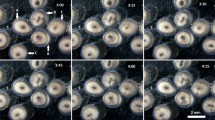Abstract
In the loach, or Oriental weatherfish Misgurnus anguillicaudatus (Teleostei: Cobitidae), diploid (2n = 50) and tetraploid individuals (4n = 100) are often sympatric in central China. The evolutionary mechanism of this tetraploidization was analyzed with the observation of meiotic behavior of chromosomes in both the germinal vesicles of mature oocytes and the primary spermatocytes in diploid and tetraploid loaches. Whereas diploid specimens usually showed 25 bivalents in meiotic cells, tetraploid loaches exhibited 0–6 quadrivalents and 38–50 bivalents in both sexes, with the modal number of quadrivalents as three in females and four in males. In the diploid specimens, the two largest metacentric chromosomes bearing nucleolar organizing regions (NORs) identified by chromomycin A3 staining and fluorescence in situ hybridization with a 5.8S + 28S rDNA probe formed one bivalent with terminal association. In the tetraploids, four NOR-bearing chromosomes never formed a quadrivalent, but were organized into two terminally-associated bivalents. These findings suggest an autotetraploid origin of the natural tetraploid loach and subsequent rediploidization of whole genome. The latter process, however, seems still in progress as inferred from the concurrence of up-to several quadrivalents and the majority of bivalents.




Similar content being viewed by others
References
Arai K (2003) Genetics of the loach, Misgurnus anguillicaudatus: recent progress and perspective. Folia Biologica (Krakow) 51(suppl):107–117
Arai K, Matsubara K, Suzuki R (1991) Karyotype and erythrocyte size of spontaneous tetraploidy and triploidy in the loach Misgurnus anguillicaudatus. Nippon Suisan Gakkaishi 57:2167–2172
Becak ML, Becak W, Rabello MN (1966) Cytological evidence of constant tetraploidy in the bisexual South American frog Odontophyrynus americanus. Chromosoma 19:188–193
Belling J, Blakeslee AF (1924) The configurations and sizes of the chromosomes in the trivalents of 25-chromosomes Daturas. Proc Natl Acad Sci USA 10:116–120
Clausen RE, Goodspeed TH (1925) Interspecific hybridization in Nicotiana. II. A tetraploid glutinosa-tabacum hybrid, an experimental verification of Winge’s hypothesis. Genetics 10:278–284
Davis BM (1933) The genetics and cytology of a tetraploid from Oenothera fransiscana Bartlett. Genetics 18:293–323
Fujiwara A, Abe S, Yamaha E, Yamazaki F, Yoshida MC (1998) Chromosomal localization and heterochromatin association of ribosomal DNA gene loci and silver-stained nucleolar organizer regions in salmonid fishes. Chromo Res 6:463–471
Giles A, Randolph LP (1951) Reduction of quadrivalent frequency in autotetraploid maize during a period of 10 years. Amer J Bot 38:12–17
Itono M, Morishima K, Fujimoto T, Bando E, Yamaha E, Arai K (2006) Premeiotic endomitosis produces diploid eggs in the natural clone loach, Misgurnus anguillicaudatus (Teleostei: Cobitidae). J Exp Zool 305A:513–523
Jenkins G, Jimenez J (1995) Genetic control of synapsis and recombination in Lolium amphidiploids. Chromosoma 104:164–168
Kagawa H, Young G, Nagahama Y (1984) In vitro estradiol-17 beta and testosterone production by ovarian follicles of the goldfish, Carassius auratus. Gen Comp Endocrinol 54:139–143
Li K, Li Y, Zhou D (1983) A comparativestudy of the karyotypes in two species of mud loahes. Zool Res 4:75–81
Li Y-J, Yin J, Wang J-B, Yuan X, Wei J, Sun X-W, Arai K (2008) A study on the distribution of polyploid loaches in China. Nippon Suisan Gakkaishi 74:177–182
Li Y-J, Tian Y, Zhang M-Z, Tian P-P, Yu Z, Abe S, Arai K (2010) Chromosome banding and FISH with rDNA probe in the diploid and tetraploid loach Misgurnus anguillicaudatus. Ichthyol Res 57:358–366. doi:10.1007/sl0228-010-0168-0
Morishima K, Horie S, Yamaha E, Arai K (2002) A cryptic clonal line of the loach Misgurnus anguillicaudatus (Teleostei: Cobitidae) evidenced by induced gynogenesis, interspecific hybridization, microsatellite genotyping and multilocus DNA fingerprinting. Zool Sci 19:565–575
Morishima K, Yoshikawa H, Arai K (2008) Meiotic hybridogenesis in triploid Misgurnus loach derived from a clonal lineage. Heredity 100:581–586
Ojima Y, Takai A (1979) The occurrence of spontaneous polyploidy in the Japanese common loach, Misgurnus anguillicaudatus. Proc Jpn Acad 55B:487–491
Schmid M, Haaf T, Schempp W (1985) Chromosome banding in Amphibia IX. The polyploid karyotypes of Odontophyrinus americanus and Ceratophrys ornate (Anura, Leptodactylidae). Chromosoma (Berl) 91:172–184
Schweizer D (1976) Reverse fluorescent chromosome banding with chromomicin and DAPI. Chromosoma (Berl) 58:307–324
Schweizer D (1980) Simultaneous fluorescent staining of R-bands and specific heterochromatic regions (DA-DAPI bands) in human chromosomes. Cytogenet Cell Genet 27:190–193
Schweizer D, Ambros P, Andrle M (1978) Modification of DAPI banding on human chromosomes by prestaining with a DNA-binding oligopeptide antibiotic, distamycin A. Exp Cell Res 111:327–332
Yoshikawa H, Morishima K, Fujimoto T, Saito T, Kobayashi T, Yamaha E, Arai K (2009) Chromosome doubling in early spermatogonia produces diploid spermatozoa in a natural clonal fish. Biol Repro 80:973–979
Zhang Q, Arai K (1999) Distribution and reproductive capacity of natural triploid individuals and occurrence of unreduced eggs as a cause of polyploidization in the loach, Migurnus anguillicaudatus. Ichthyol Res 46:153–161
Zhang Q, Arai K (2003) Extensive karyotype variation in somatic and meiotic cells of the loach Misgurnus anguillicaudatus (Pisces: Cobitidae). Folia Zool 52:423–429
Zhang Q, Arai K, Yamashita M (1998) Cytogenetic mechanisms for triploid and haploid egg formation in the triploid loach Misgurnus anguillicaudatus. J Exp Zool 281:608–619
Acknowledgments
This study is supported in part by Grants-in-Aid for Scientific Research (B) (No. 21380114) from the Japan Society for the Promotion of Science (JSPS) to KA and for Ronpaku (Dissertation Ph.D) Program (CSC-10610) from JSPS to YJL.
Author information
Authors and Affiliations
Corresponding author
Rights and permissions
About this article
Cite this article
Li, YJ., Yu, Z., Zhang, MZ. et al. The origin of natural tetraploid loach Misgurnus anguillicaudatus (Teleostei: Cobitidae) inferred from meiotic chromosome configurations. Genetica 139, 805–811 (2011). https://doi.org/10.1007/s10709-011-9585-x
Received:
Accepted:
Published:
Issue Date:
DOI: https://doi.org/10.1007/s10709-011-9585-x




